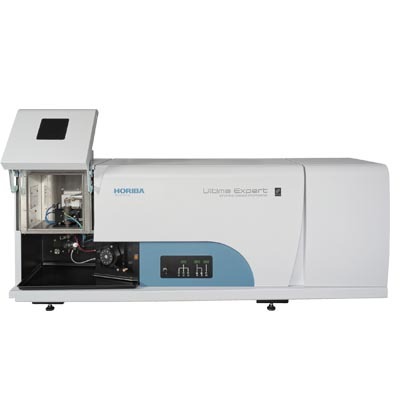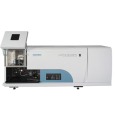
方案详情
文
Because the aim of the analysis lubricating oils is to monitor the oil of an engine and get a trend analysis over time, the best accuracy is not required. The trend analysis allows the analyst to see that the oil is changing and when the engine needs stripping down before a catastrophic failure. The use of the internal standard is not required because the results are only compared to previous results. The procedure is thus very simple: new two point calibration each time the sample is analyzed and dilution of the samples by 1:5, 1:10 or 1:100, depending on the viscosity of the oil samples and whether lower detection limits are required.
方案详情

ICP ATOMIC EMISSION SPECTROSCOPY 1 Introduction This Application Note describes a classicalmethod for the analysis of lubricating oils. Thespectrometric analysis of lubricating oil is com-mon practice where large amount of lubricatingoils are involved or where engine wear is criti-cal. For example, it is used to control oil fromplanes, boats, buses, trains, and large automo-tives. The same oil is sampled over a period oftime and analyzed, and by monitoring of theconcentrations of the wear metals enables iden-tification engine component suffering wear. 2 Principle 2.1 Technique used The elemental analysis of solutions was under-taken by Inductively Coupled Plasma AtomicEmission Spectrometry (ICP-AES). The sampleis nebulized then transferred to an argon plas-ma. It is decomposed, atomized and ionizedwhereby the atoms and ions are excited. Wemeasure the intensity of the light emitted whenthe atoms or ions return to lower levels of ener-gy. Each element emits light at characteristicwavelengths and these lines can be used forquantitative analysis after a calibration. 2.2 Wavelength choice The choice of the wavelength in a given matrixcan be made using the "profile" function, or byusing Win-IMAGE, which is rapid semi-quantita-tive analysis mode using multiple wavelengths.The principle is the same in either case: recordthe scans of analytes at low concentration, andof the matrix. By superimposing the spectra, wesee possible interferences. 3 Sample Preparation Different oil samples can have a large variationin their viscosity, ranging from 50 to 1000 cs. Sothe nebulization efficiency of the oil can be verydifferent from one oil sample to the next. Todecrease the viscosity and to obtain the sameviscosity value for all samples, they were dilut-ed by 10 in kerosene, white spirit, xylene or ker-dane. For viscous oils of 1000 cs, a 100 dilutionis required. 4 Instrument specification The work was done on a JY 2000.The specifica-tions of this instrument are listed below inTables 1 and 2. Table 1: Specification of spectrometer Parameters Specifications Mounting Czerny-Turner Focal length 0.64 m Grating number of grooves 2 400 gr/mm Variable resolution No Nitrogen purge Yes Table 2: Specification of RF Generator Parameters Specifications Observation Radial Frequency 40.68 MHz Control of gas flowrate By computer Control of pump flow By computer Cooling Air 5 Operating conditions The operating conditions are Ilisted in Table 3below. Table 3: Operating conditions Parameter Condition RF Generator power 1200 W Plasma gas flowrate 14 L/min Auxiliary gas flowrate 0.8 L/min Sheath gas flowrate 0.3 L/min Nebulizer flowrate 2.51 bars Sample uptake 0.8 mL/min Type of nebulizer JY 0.7 Type of spray chamber Scott Argon humidifier No Injector tube diameter 3.0 mm 6 Wavelength selection and analyti-cal conditions Table 4: Wavelength selection and analytical con-ditions Element MeasuredAnalysis Integration points/ mode time calculated points (sec) Ag 7/5 Gaussian 0.2 AI 7/5 Gaussian 0.1 B 7/5 Gaussian 0.1 Ca 7/5 Gaussian 0.1 Cr 7/5 Gaussian 0.1 Cu 7/5 Gaussian 0.1 Fe 7/5 Gaussian 0.1 Mo 7/5 Gaussian 0.1 Pb 7/5 Gaussian 0.1 Si 7/5 Gaussian 0.1 Sn 7/5 Gaussian 0.2 Zn 7/5 Gaussian 0.1 Table 5: High calibration standard Element High calibration point (ppm) Ag 10 Al 50 B 100 Ca 5000 Cu 150 Cr 100 Fe 200 Mo 100 Pb 150 Si 50 Sn 10 Zn 100 7 Limits of detection The limits of detection are calculated using thefollowing formula: With: LOD = limit of detection, k=3 for the normal 3-sigma values, BEC= Background equivalent concentration, RSDo= relative standard deviation of the blank. To calculate the LOD, a calibration curve is con-structed using two points, 0 ppm and 5 ppm, orsome concentration where the calibration is linear;this gives the BEC. The RSDo is evaluated by run-ning the blank ten times. Typical detection limits in a solution of 10 %oil inkerosene are shown in Table 6 below. Table 6: Limits of detection Element Wevelength (nm) LOD (ppb) Ag 328.068 1.4 Al 167.020 2.3 AI 308.215 6.5 Al 396.152 9.9 B 249.773 4.5 Ba 455.403 0.2 Ca 317.933 1.5 Cd 228.802 1.3 Cu 324.754 0.7 Mg 279.553 0.5 Mn 257.610 0.5 Mo 202.030 2.0 Na 588.995 4.9 Ni 231.604 0.9 P 178.229 14.4 Pb 220.353 20.2 Si 251.611 3.4 Sn 189.989 14.7 Ti 334.941 1.1 V 292.402 0.8 V 310.230 0.5 Zn 213.856 1.0 Because the aim of the analysis lubricating oils isto monitor the oil of an engine and get a trendanalysis over time, the best accuracy is notrequired. The trend analysis allows the analyst tosee that the oil is changing and when the engineneeds stripping down before a catastrophic fail-ure.The use of the internal standard is notrequired because the results are only compared toprevious results. The procedure is thus very sim-ple: new two point calibration each time the sam-ple is analyzed and dilution of the samples by 1:5,1:10 or 1:100, depending on the viscosity of the oilsamples and whether lower detection limits arerequired. France: HORIBA Jobin Yvon S.A.S., 16-18 rue du Canal, 91165 Longjumeau Cedex- Tel: +33 (0)1 64 54 13 00-Fax: +33 (0)1 69 09 07 21 -Email: info-sci.fr@horiba.comUSA: HORIBA Jobin Yvon Inc., 3880 Park Avenue, Edison, NJ 08820-3012. Toll-free: +1-866-jobinyvon-Tel: +1-732-494-8660-Fax: +1-732-549-5125Email: info-sci.us@horiba.com Japan: HORIBA Ltd., Scientific Instruments Sales Dept., Alte-Building Higashi-Kanda, 1-7-8 Higashi-Kanda, Chiyoda-ku, 101-0031 Tokyo - Tel:+81 (0)3 38618231Fax: +81 (0)3 3861 8259-Email: info-sci.jp@horiba.comGermany: HORIBA Jobin Yvon GmbH, Hauptstrasse 1, 82008 Unterhaching-Tel: +49 (0)89 46 23 17-0-Fax: +49 (0)89 46 23 17-99-Email: info-sci.de@horiba.comItaly: HORIBA Jobin Yvon Srl, Via Cesare Pavese 35/AB, 20090 Opera (Milano)- Tel: +39 0 2 57 60 30 50- Fax: +39 0 257 60 08 76-Email: info-sci.it@horiba.comUK: HORIBA Jobin Yvon Ltd, 2 Dalston Gardens, Stanmore, Middlesex HA7 1BQ - Tel: +44 (0)20 8204 8142- Fax: +44 (0)20 8204 6142-Email: info-sci.uk@horiba.com China: HORIBA Jobin Yvon SAS, Room 1801, Capital Tower No.6, Jianguomenwai Av., Chaoyang District, Beijing 100022- Tel: +86 (0)10 8567 9966-Fax: +86 (0)10 8567 9066 Email: info-sci.cn@horiba.com Other Countries: Tel: +33 (0)1 64 5413 00-Email: info.sci@horiba.com HORIBAExplore the futureAutomotive Test Systems Process & EnvironmentalMedical Semiconductor Scientific Because the aim of the analysis lubricating oils is to monitor the oil of an engine and get a trend analysis over time, the best accuracy is not required. The trend analysis allows the analyst to see that the oil is changing and when the engine needs stripping down before a catastrophic failure. The use of the internal standard is not required because the results are only compared to previous results. The procedure is thus very simple: new two point calibration each time the sample is analyzed and dilution of the samples by 1:5, 1:10 or 1:100, depending on the viscosity of the oil samples and whether lower detection limits are required.
确定



还剩1页未读,是否继续阅读?
HORIBA(中国)为您提供《润滑油中硼检测方案(ICP-AES)》,该方案主要用于润滑油中含量分析检测,参考标准--,《润滑油中硼检测方案(ICP-AES)》用到的仪器有HORIBA Ultima Expert高性能ICP光谱仪
相关方案
更多
该厂商其他方案
更多









